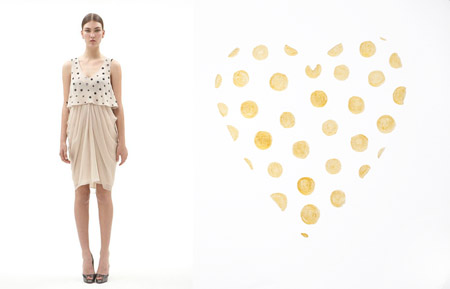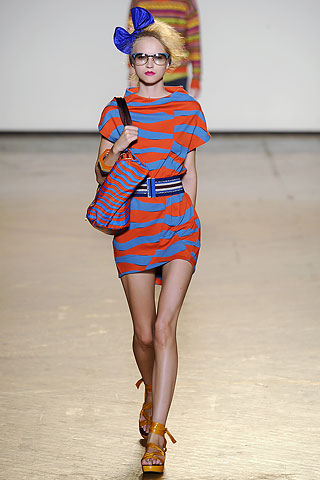When the economy slides south, the press suddenly herds the people into one faceless blob: the Masses, clamoring for help, crying for change, yearning to be heard and helped by their leaders. Not so in the upside-down world of Fashion Week. At the Marc Jacobs show, people were Individuals. Unique was the word of the moment. Striding down the runway, each model showed off a uniquely painted face (courtesy of François Nars, his first show in a decade) and uniquely formed hair (think the B-52’s and Flock of Seagulls). The boldly hued, wildly theatrical makeup and styling brought memories of the 1980’s, or more precisely the heydays of glam and punk rock, flash-dancing into your mental foreground.
The light-show we saw above the neck—at once neon and sculptural, like a radiating hunk of fallen meteorite—was reflected below, of course. These clothes were, according to Jacobs, “all about clubbing in the 80’s, when New Yorkers could have fun, be creative. Not like now.” Most people view high fashion as the peak of escapism, but it’s not until we’re caught in a once-in-a-lifetime global downturn that designers come right out and say, yes, absolutely, the world is circling the drain, and my clothes will help you forget that. Through this dark patch, Jacobs is saying, you can be the torch.
The Times’ Cathy Horyn is reminded of Jacobs’ early days, which inevitably gave way to his glamorous image of designer as rock star. Indeed, it seemed foreordained, this blend of Sprouse revivalism and rock-video chic. Those that know Jacobs also know that the late Stephen Sprouse, cult icon of mid-80’s downtown art-punk couture, was a hero to him. It wouldn’t be outlandish to attribute Jacobs’ rise to his brilliant resuscitation of Sprouse’s aesthetic, sneaked in 2001 into Jacobs’ designs, which paid off a famous bet by Louis Vuitton on this subversive upstart.
The word is that the Jacobs show lasted less than ten minutes, starting at 7:59 and, going by concluding at 8:08. Given his usual weakness for cinematic Fashion Week spectacle, outsize sets with thumping soundtracks, this is the extreme end of minimalism. Over at the 69th Regiment Armory on Lexington Avenue, the usual venue, the list of allowed attendees plummeted from 2,000 to an intimate and cheap, if frustratingly exclusive, 700. Tightening the belt like everyone else!
Edges serrated like a knife, jewel-bright pencil skirts, jutting shoulders that approximate cliffs. Rebellious, yes, but also surprisingly architectural in its overlapping symphony of folds and pleats. Add the tapered pants and sliced tops to the equation and it is obvious that this collection falls more on the couture end than the ready-to-wear end of the spectrum. They have a time-capsule quality, too, that would discourage most. In the end, the fluorescent fantasia of the Marc Jacobs show offers a sharp contrast to the offerings of—for instance—Nicole Miller, DKNY, and Diane von Furstenburg, who tendered a vision more grounded in reality, honoring the day-to-day without dipping into the pedestrian or the ordinary.





